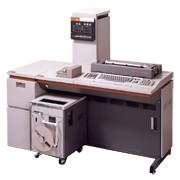A high-speed, large-capacity, compact, full-fledged data processing system.
Ricoh launched the RICOM 8 in April 1971 as its very first office computer, which was developed jointly with TDK. The RICOM 8 made use of a magnetic core memory, consisting of either 2 kilobytes or 4 kilobytes of memory, that TDK had developed as a world first. The Ricoh Typer I/O unit simplified data input operations and had had a long track record since its introduction in 1964. The office computer boasted the excellent performance of its 64-bit arithmetic unit, and it gained attention for its space-saving tower design.
Designed for business processes, the RICOM 8 used decimal notation for all operations. Because it could run basic 16-digit arithmetic operations and had a data editing function (addition commands) that was essential for business processes, the market viewed it as the ideal office computer for office processes, such as billing, that required frequent data I/O operations. Bundled software included assembler — the system’s basic program, Fortran, a debugging program, and other utilities. Ricoh also developed user-specific application programs on request. Data I/O and processing was done automatically by programs stored in the memory unit of the central arithmetic unit. The basic memory could hold up to 500 words and was expandable to 2000 words in 500-word stacks. The command set of 35 instructions allowed the RICOM 8 to be used for both business processes and scientific computation processes. All circuitry used solid-state ICs for fast, highly reliable data processing.


